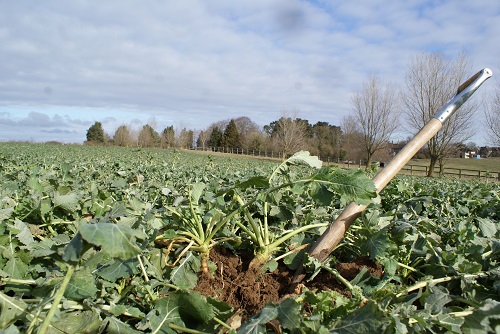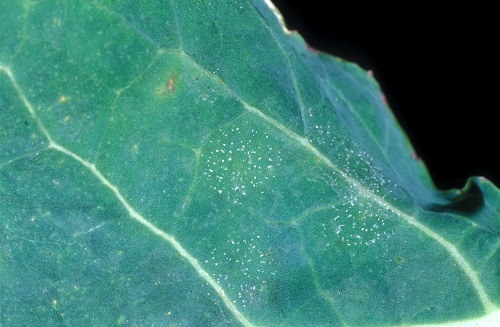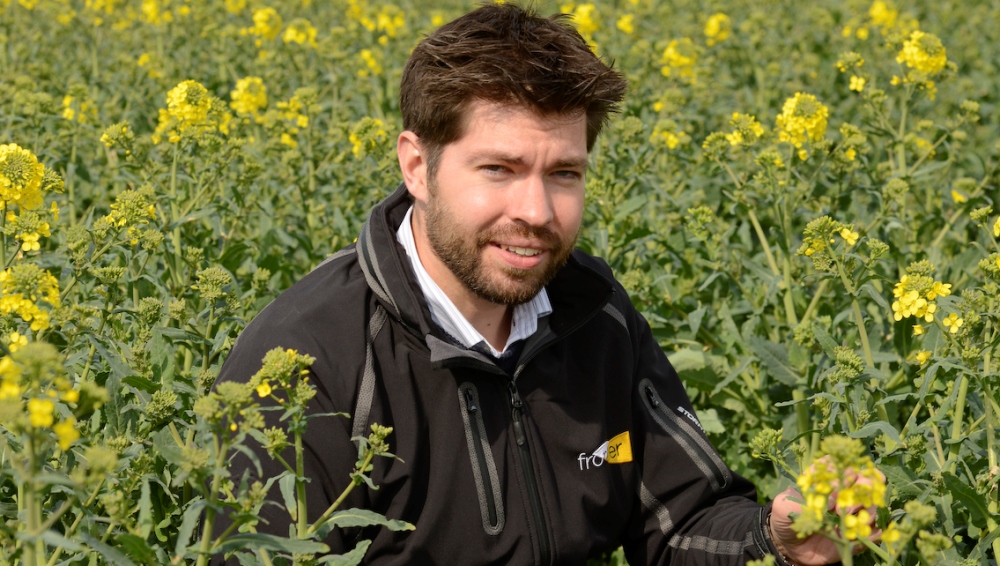Oilseed rape has been through some tough times of late. CPM finds out how the crop’s looking as we head towards spring.
Make PGR decisions on a case-by-case basis.
By Lucy de la Pasture
What a difference a year makes. Growers who have kept the faith with oilseed rape look set to be rewarded for their loyalty to the oft-problematic break crop. It hasn’t been a case of sunshine and roses throughout the country but, on the whole, the national OSR crop looks to have potential.
Ben Burrows, independent agronomist with Crop Management Partners, reports the majority of his OSR crops in Hants, Oxon and Wilts had good autumn establishment and are coming out of the winter looking well.

Penthiopyrad is said to help rooting so Ben Burrows tested it in a field trial to see for himself.
“In some areas of Oxon and Bucks, crops suffered patchy germination under dry conditions and were subsequently hammered by flea beetle but further south of my region crops got away well.”
In the south east of England, the combined effects of a droughty autumn and flea beetle took a much greater toll on OSR, leaving Zantra technical director, Chris Bean, with just a handful of fields this spring – the remainder already ripped up and replanted with something else.
“The OSR I’m left with falls into one of three categories – good, moderate and very marginal. If the decision is made to stick with the borderline-looking fields then these will be lower input crops because they lack yield potential. The remainder I’ll probably treat in a relatively similar fashion. As long as the plants are relatively evenly spread, the fields that are looking moderate now will often go on to produce decent crops,” he says.
On the plus side, post-emergence weed control seems to have worked well this winter and Chris Bean opted for Astrokerb (aminopyralid+ propyzamide) where poppies were a problem and Kerb (propyzamide) where brome and volunteers were the main targets.

Levels of LLS have increased rapidly in Herefordshire over the past few weeks.
There’s always an argument for and against using a pre-emergence herbicide, but more and more growers want to make sure the crop establishes before spending money on it, he points out.
“The Clearfield route is becoming more popular because it allows you to do this as well as giving good control of some of the tricky-to-control brassica weeds, like hedge mustard. For some reason the Clearfield crops in this part of the world seem to have withstood the autumn drought better than other varieties,” he notes.

Paul Cartwright notes that pyrethroids seem to have been more effective last autumn.
Frontier’s crop production specialist, Paul Cartwright, also reports good levels of performance from Kerb and Astrokerb and believes that the chemistry is still working.
“It was relatively dry up until Christmas which means the propyzamide won’t have been washed down through the soil profile too quickly this season, resulting in a long period of weed control.
As the OSR crop prepares to race through its growth stages like Usain Bolt, Ben Burrows’ OSR fields with smaller canopies have had a tickle of Feb-applied nitrogen to fettle them, he says.
Managing canopy size is all important in OSR with the aim of achieving a GAI of 3-4 at mid-flowering. For more forward crops, that means PGR decisions may need to be made as the crop reaches stem extension, adds Paul Cartwright.
“If plants are forward and large then you don’t want them to get too big and hungry so a PGR is an easy decision. But you can also consider branching and factor the architecture of the canopy into PGR decisions. So if the seed rate was reasonably high to mitigate against the risks of slugs or flea beetle and a good percentage of plants have survived, then a PGR application would be advisable to maximise yield.
“Make PGR decisions on a case-by-case basis and don’t be afraid not to apply one at stem-extension. There’s scope to revisit the PGR decision and apply later, at green-bud, if you feel it’s needed later,” he advises.
Waiting for this later timing to make PGR decisions is what Chris Bean is anticipating this year on his crops.
“I may plan a fungicide at late stem-extension to early green-bud or I may wait until early flowering. It will depend entirely on the climatic conditions we’re under,” he says, adding that pigeons may still have a part to play in his part of the world.
“Last year, pigeons were a massive problem but so far the flocks don’t seem to be so big. Pigeons will be getting hungry now and start homing in on any crop that looks worth eating,” he says, hoping that damage won’t be more than a little natural growth regulation.
Flea beetle larvae don’t appear to be quite as much of a problem as they were last year, but it very much depends where you are in the country, reckons Paul Cartwright.
“Larvae are easy to find feeding in the branches and stems of OSR at our Hants trial site but they’re not threatening the crop. Although where flea beetle larvae can be found, it will be a stress factor for the crop. It’s important to make sure the crop doesn’t get put under any additional stress, such as nutrient shortages.
“OSR has an amazing capacity to compensate for a number of individual ills, but not all at the same time. Some things like water availability and adequate solar radiation are in the lap of the gods so there’s an element of pray for rain and sun at the right times too,” he adds.
On the subject of flea beetle, Paul Cartwright notes that in some cases pyrethroids seemed to have had a better autumn, with control levels above those seen in recent autumns.
“Quite why this should be, I’m not sure but there may have been a slightly more sensitive flea beetle population or it’s down to better application in optimal conditions,” he suggests.
Light leaf spot (LLS) and phoma are generally agreed not to be at the levels seen last season, with many crops described as ‘relatively clean’.
“In most cases autumn fungicides for phoma control were applied and it’s been a much more normal weather pattern than last year, when extended mild, wet conditions prolonged disease development in the crop.
“In poorer crops or ones that didn’t receive an autumn fungicide, LLS and a bit of phoma are present so it’ll be important to make sure new growth is protected. LLS can be damaging before there are visible signs, so incubating leaves to see if anything develops is a good way of catching infection early,” he advises.
Resistance management of LLS is something to bear in mind when designing fungicide programmes, with some azole-resistant LLS strains having been identified in the UK, even if field efficacy currently remains good, reminds Paul Cartwright.
Some of Chris Bean’s crops had an autumn spray of Cypher (penthiopyrad+ picoxystrobin) and he’s not expecting to see much LLS on his chalk downland. His main priorities over the coming weeks are getting nitrogen and sulphur on and perhaps some spring phosphate to encourage rooting on crops that didn’t receive Cypher in the autumn, he says.
It’s an autumn fungicide strategy Ben Burrows agrees with after carrying out an on-farm assessment to verify whether there was any substance to the claim that penthiopyrad helped increase autumn rooting.
“The results showed a statistically significant increase in taproot length of 2.6cm and more consistent rooting across the whole where Refinzar (penthiopyrad+ picoxystrobin) was applied,” he explains.
As part of his study, he also looked at the levels of disease control achieved with Refinzar compared to Difcor (difenoconazole).
“The Refinzar treatment seemed to begin its curative activity faster than the Difcor, and managed to reduce the phoma infection from its initial level. In contrast, the Difcor seemed to only slow the rate of phoma development in the crop,” he explains.
Ben Burrows reports levels of phoma are now very low or non-existent in crops, whereas in the autumn there was sufficient phoma to warrant fungicide application. He hasn’t seen much LLS either but points out that variety choice was geared towards those that showed good levels of LLS resistance.
However, ADAS senior researcher Julie Smith advises growers to stay vigilant and not overlook the disease.
“Light leaf spot has started to show up in crops within the past 2-3 weeks in some areas but because it appeared later than in 2016 many growers feel they’re in the clear. Don’t be fooled, we’ve crops which are rated 5 and 6 and have seen LLS increase from 2 to 75% incidence in just over a fortnight. When it takes hold it can escalate rapidly,” she warns.
Making an appearance again this season is clubroot, with infection showing up on farms where it’s never been a problem before and on virgin ground. But Julie Smith, isn’t altogether surprised at the number of cases.
“In collaboration with SRUC, we conducted a field survey as part of a previous AHDB-funded clubroot project (RD-2007-3373, 2007-11) and found a much higher percentage of clubroot infection in land than expected. Survey work showed that the disease was present in all areas of the UK where oilseed rape was grown and 52% of the surveyed sites tested positive for clubroot inoculum in the soil. These positive test results were often at sub-clinical levels in the crop,” she comments.
This year has been relatively mild which has undoubtedly exacerbated the problem because the pathogen needs soil temperatures to be above 16oC for infection to occur. Comparing soil temperature data from 2015 and 2016 showed that infection was still possible into the first week of Oct in 2016, assuming that soil water was not a limiting factor, explains Julie Smith.
In an average year, the window of infection – determined by soil temperatures – extends until approximately the end of Aug. Investigating the effect of drilling date is something ADAS is looking at, explains ADAS technician Dennis Churchill, who assists Julie Smith on clubroot research.
“We’re running a sowing date experiment in Herefordshire and data so far shows that plots drilled on 6 Sept have 80% clubroot infection, whereas late sown plots (20 Sept) are clean. The yield data will be interesting because there’s usually a penalty associated with late sown OSR, but the avoidance of clubroot through later drilling this year may shift the balance,” he comments.
One of the problems with clubroot is that infection needs to be quite severe before there are obvious above ground disease symptoms, adds Julie Smith.
“To find clubroot in the early stages, agronomists need to pull plants and look at the roots, though this is complicated by the fact that the disease is also notoriously patchy in occurrence.”
Published research shows that for every 10% of plants infected, yield is reduced by 0.3t/ha, so losses in affected crops can be over 50% of potential yield in the most severely infected crops. But complete plant loss is possible early season, with surviving plants suffering from the root galls caused by the disease, she explains.
“I’ve seen yield penalties of more than more than 2t/ha in crops that have survived infection. The worrying fact about clubroot is that the resting spores are very robust and can last up to 20 years. The half-life of clubroot is approximately 4.5 years, which means levels of inoculum decline very slowly in the soil,” she says.
Exudates from host plant roots, which include common weeds such as charlock and shepherds purse, stimulate resting spores to germinate, so inoculum can continue to build even in the absence of an oilseed rape crop. All in all, once soil is infected it’s a disease that’s very difficult to get rid of.
The risk of clubroot’s something we could be more tuned into, believes Paul Cartwright. “Longer rotations of 4-5 years will help to delay build-up. Boron is an important nutrient in OSR and most crops will benefit from a foliar application in the spring, but where clubroot starts to appear in patches, boron becomes one of the most essential management tools that you can use to help the crop cope with the stress,” he believes.




